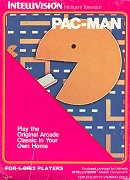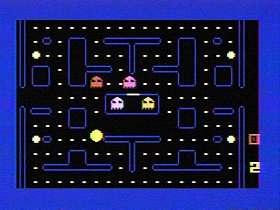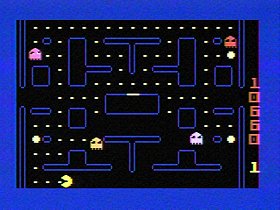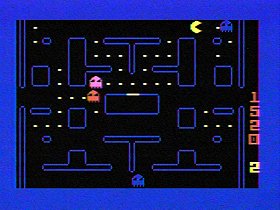 The Game: As a round yellow creature consisting of a mouth and nothing else, you maneuver around a relatively simple maze, gobbling small dots and evading four colorful monsters who can eat you on contact. In four corners of the screen, large flashing dots enable you to turn the tables and eat the monsters for a brief period for an escalating score . Periodically, assorted items appear near the center of the maze, and you can consume these for additional points as well. The monsters, once eaten, return to their home base in ghost form and return to chase you anew. If cleared of dots, the maze refills and the game starts again, but just a little bit faster… (Atarisoft, 1983; re-released by INTV Corp., 1984)
The Game: As a round yellow creature consisting of a mouth and nothing else, you maneuver around a relatively simple maze, gobbling small dots and evading four colorful monsters who can eat you on contact. In four corners of the screen, large flashing dots enable you to turn the tables and eat the monsters for a brief period for an escalating score . Periodically, assorted items appear near the center of the maze, and you can consume these for additional points as well. The monsters, once eaten, return to their home base in ghost form and return to chase you anew. If cleared of dots, the maze refills and the game starts again, but just a little bit faster… (Atarisoft, 1983; re-released by INTV Corp., 1984)
Memories: This version of the world’s most famous coin-op does not disappoint. It’s a little surprising that Atari could do a better Pac-Man for the Intellivision than it could for the VCS. And, not to insult Mr. Tod Frye, who programmed the 2600 version of Pac-Man, but the programmer of Atarisoft’s Intellivision translation of the game was someone who had previously worked for Mattel Electronics itself, and knew how to milk the most out of the machine’s graphics and sound capabilities. And what a difference it made!
 Not only are the sounds and music exceptional, but the maze – while not quite the reformatted-to-fit-your-TV copy of the arcade game maze featured in Atari 5200 Pac-Man – is at least closer to the original than what can be found on the 2600 version. And the coup de grace? Intellivision Pac-Man includes all of the coin-op’s intermissions, music and all.
Not only are the sounds and music exceptional, but the maze – while not quite the reformatted-to-fit-your-TV copy of the arcade game maze featured in Atari 5200 Pac-Man – is at least closer to the original than what can be found on the 2600 version. And the coup de grace? Intellivision Pac-Man includes all of the coin-op’s intermissions, music and all.
Pac-Man for the Intellivision is also a title that truly falls into the rare category of collectible games. Initially released by Atarisoft, Pac-Man featured the “peeled-back page” artwork typical of Atari’s titles for other consoles at the time. But when Atari’s  fortunes ran afoul of the prevailing market winds, all of its Atarisoft titles were discontinued. Having taken note of the game’s popularity and critical acclaim, INTV Corp. – a company which had been formed to keep the Intellivision alive after Mattel shuttered the electronics division which originally supported the machine – arranged to license the game from Namco and manufacture it on its own. The new box, which retained part of Atari’s layout, was more in line with other Intellivision releases, and featured a cartridge in the more traditional shape of a Mattel-manufactured casing with a white label that simply read “Pac-Man” – and it is this version which die-hard game collectors consider more desirable. Ironically, the instruction sheet – including Atari’s copyright notice – remained the same across both packaging variations.
fortunes ran afoul of the prevailing market winds, all of its Atarisoft titles were discontinued. Having taken note of the game’s popularity and critical acclaim, INTV Corp. – a company which had been formed to keep the Intellivision alive after Mattel shuttered the electronics division which originally supported the machine – arranged to license the game from Namco and manufacture it on its own. The new box, which retained part of Atari’s layout, was more in line with other Intellivision releases, and featured a cartridge in the more traditional shape of a Mattel-manufactured casing with a white label that simply read “Pac-Man” – and it is this version which die-hard game collectors consider more desirable. Ironically, the instruction sheet – including Atari’s copyright notice – remained the same across both packaging variations.
Another trivia note brings some even sharper irony to this game. The designer who parsed Pac-Man for the Intellivision had been hired away from Mattel Electronics itself – where he had earlier worked on the Intellivision’s first-ever coin-op license, Lock ‘N’  Chase – a Pac-Man clone. That’s like working on the original Battlestar Galactica one moment and then moving on to an honest-to-God Star Wars movie the next.
Chase – a Pac-Man clone. That’s like working on the original Battlestar Galactica one moment and then moving on to an honest-to-God Star Wars movie the next.
 All in all, once one masters the technique of keeping Pac-Man moving in a straight line with the joy-disc, Pac-Man is incredibly fun – and proof that history could have changed radically, had Mattel gotten the rights to the game instead of Atari.
All in all, once one masters the technique of keeping Pac-Man moving in a straight line with the joy-disc, Pac-Man is incredibly fun – and proof that history could have changed radically, had Mattel gotten the rights to the game instead of Atari.